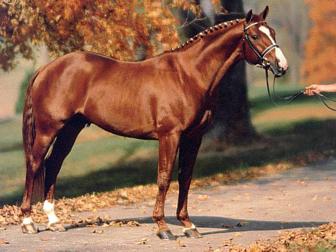
OVERVIEW
The ancestor of the Hanoverian horse was the German "war horse" of the Middle Ages. With the passing of the armored knight, the Hanoverian was bred with Spanish and Oriental horses to change its conformation for use as a cavalry horse. This new Hanoverian horse was capable of working under saddle, in harness on the farm or drawing carriages. In 1735, King George II of England (a German) founded the famous Landgestiit Celle which is to this day the official stud and training facility with over 200 stallions. Today the Hanoverian has been crossed with more Thoroughbred blood, as well as, Trakehner. It proves a superlative hunter, dressage and show jumping horse.
PHYSICAL DESCRIPTION
The Hanoverian's conformation reflects the influence of considerable cross-breeding in recent years. It stands between 16 and 17.1 hands and has a substantial body. Its shoulders and chest are large and the back is long. The neck is of medium size, the head is rather long and narrow, and the legs are clean. It appears in various colors: brown, chestnut, bay and black being the most common.
ORIGIN
The Hanoverian Horse gains its name from its place of origin: the province of Hanover, Lower Saxony, in western Germany. The blood lines of the breed reach back at least to the early Middle Ages. It has been crossed with many other breeds - most notably Thoroughbred and Trakehner - to attain its current conformation.
INTERESTING FACTS
Elector Ernest Augustus (1629-1698) adopted the white horse for his coat of arms. The Electress Sophia began the development of the famous white or cream Hanoverian coach horses. A long tradition already existed in preference for white German horses. The Hanoverian Creams, also known as Isabellas, were used in British royal processions from the reign of George I to George V, when they were replaced by the Windsor Greys.
INFLUENCES
1. Thoroughbred
2. Holsteiner
3. Trakehner
For more information:
The American Hanoverian Society, Inc.